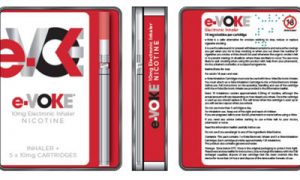Tobacco Companies Voluntarily Slap Lengthy Health Warnings on Electronic Cigarettes
For decades, tobacco companies fought lengthy legal battles to keep health warnings off their cigarette packs, which makes their decision to voluntarily include lengthy warnings on their electronic cigarette packs that more strange.
 Virtually every respectable e-cigarette brand has very clear warnings regarding the use of nicotine by adults only, the addiction caused by nicotine or the dangers it poses when used by pregnant women included on the packaging. Since the sector is not yet regulated, these warnings are not required by law, yet they have been around for a while now. But they seem like amateur work compared to the elaborate essays tobacco companies like Altria or Reynolds American have recently added to their proprietary e-cigs.
Virtually every respectable e-cigarette brand has very clear warnings regarding the use of nicotine by adults only, the addiction caused by nicotine or the dangers it poses when used by pregnant women included on the packaging. Since the sector is not yet regulated, these warnings are not required by law, yet they have been around for a while now. But they seem like amateur work compared to the elaborate essays tobacco companies like Altria or Reynolds American have recently added to their proprietary e-cigs.
As documented by the New York Times in a recent feature article, Altria’s Mark Ten e-cigarette packaging reads that “nicotine is addictive and habit forming, and is very toxic by inhalation, in contact with the skin, or if swallowed,” while Reynolds American claims its VUSE e-cigarette is not intended for persons “who have an unstable heart condition, high blood pressure, or diabetes; or persons who are at risk for heart disease or are taking medicine for depression or asthma.” These are just excerpts from the very lengthy warnings inscribed on the packs, which cover just about every angle.
As baffling as this may seem, the warnings on e-cigarette packs sold by Big Tobacco are far more elaborate than those found on conventional tobacco cigarettes. For example, you’ll have a tough time finding a cigarette pack with warnings about nicotine being “very toxic”, but that is stated very clearly on tobacco companies’ e-cigarette packaging! And that is just one example. Why would they go through the trouble of “doing the right thing” with e-cigarettes when they’ve been trying to avoid just that with the potentially deadly product they’ve been selling for decades?
That’s the question that has left many experts scratching their heads. Some believe these warnings are a very low-risk way for tobacco giants to protect themselves from future lawsuits, while, at the same time, appearing more responsible to both consumers and lawmakers that are currently working on regulations for electronic cigarettes. In an interview with the NY Times, Cynthia Cabrera, executive director of the Smoke-Free Alternatives Trade Association, went even further, calling Big Tobacco’s e-cigarette warnings ‘disingenuous’ and claiming that they have an ulterior motive. She cited the part that reads nicotine is “very toxic” when inhaled, swallowed or brought in contact with the skin, which is not true for the small doses found in e-liquid.
Regarding Big Tobacco’s reasons for the warnings, Cynthia Cabrera suspects they are trying to appear more credible and responsible compared to small e-cigarette companies so that they can lobby for rules and regulations that would favor them. She added that she has information that lobbyists are already telling regulators and lawmakers that prepackaged, uniform e-cigarettes pose a lesser health risk than vaporizers sold in specialty vapor shops.
Obviously, tobacco companies dismiss these claims, saying they are merely trying to be open about their products. William Phelps, a spokesman for Altria, told The Times that the warnings on the Mark Ten reflect “a goal to openly and honestly communicate about health effects” and that they are based on scientific research and previously developed warnings for nicotine products. Stephanie Cordisco, president of the R.J. Reynolds Vapor Company had previously told the New York Times that her company was trying to separate itself from the negative reputation of tobacco cigarettes. “We’re her to make sure we can put this industry on the right side of history,” she said.
That all sounds very noble, but why haven’t they taken the same approach with the already proven health hazard called tobacco cigarettes. Altria’s William Phelps tried to answer that question by saying his company uses smoking warnings mandated by the Government. But, as NY Times journalist Matt Richtell notes, the Government does not forbid stronger warnings from appearing on cigarette packs. Dr. Robert K. Jackler, a professor at the Stanford School of Medicine who does research on cigarette and e-cigarette advertising, asks: Why wouldn’t you warn about ‘very toxic’ nicotine on your cigarettes when you do so on e-cigarettes?
But regardless of what the warnings say and how lengthy and elaborate they are, one thing is for sure, consumers usually ignore them. A 2007 study by the Center for Disease Control and Prevention found that people, smokers in particular, pay no mind to this kind of warnings. Another report by the Annenberg Policy Center also states that the effect of warning labels has “drastically weakened” since they were first introduced in 1984, to the point that they are now “virtually meaningless”. After 40 years of battling to ensure such warnings don’t appear on their cigarette pack, you can be sure tobacco companies know very well the low impact these warnings have on their sales.
Allan M. Brandt, professor of the history of medicine and science at Harvard University and an expert in the tobacco industry, confirms that tobacco companies “know that even these types of very serious warnings have generally not put significant dents in their sales.” In fact, he says they have become a part of their strategy to create scientific grey areas. “It’s an incredibly effective and duplicitous practice in inventing additional new uncertainties and, at the same time, appearing to be cooperative,” Professor Brandt said. “They’ve done this before, it buys them time. It bought them 40 years with traditional tobacco products.”
















